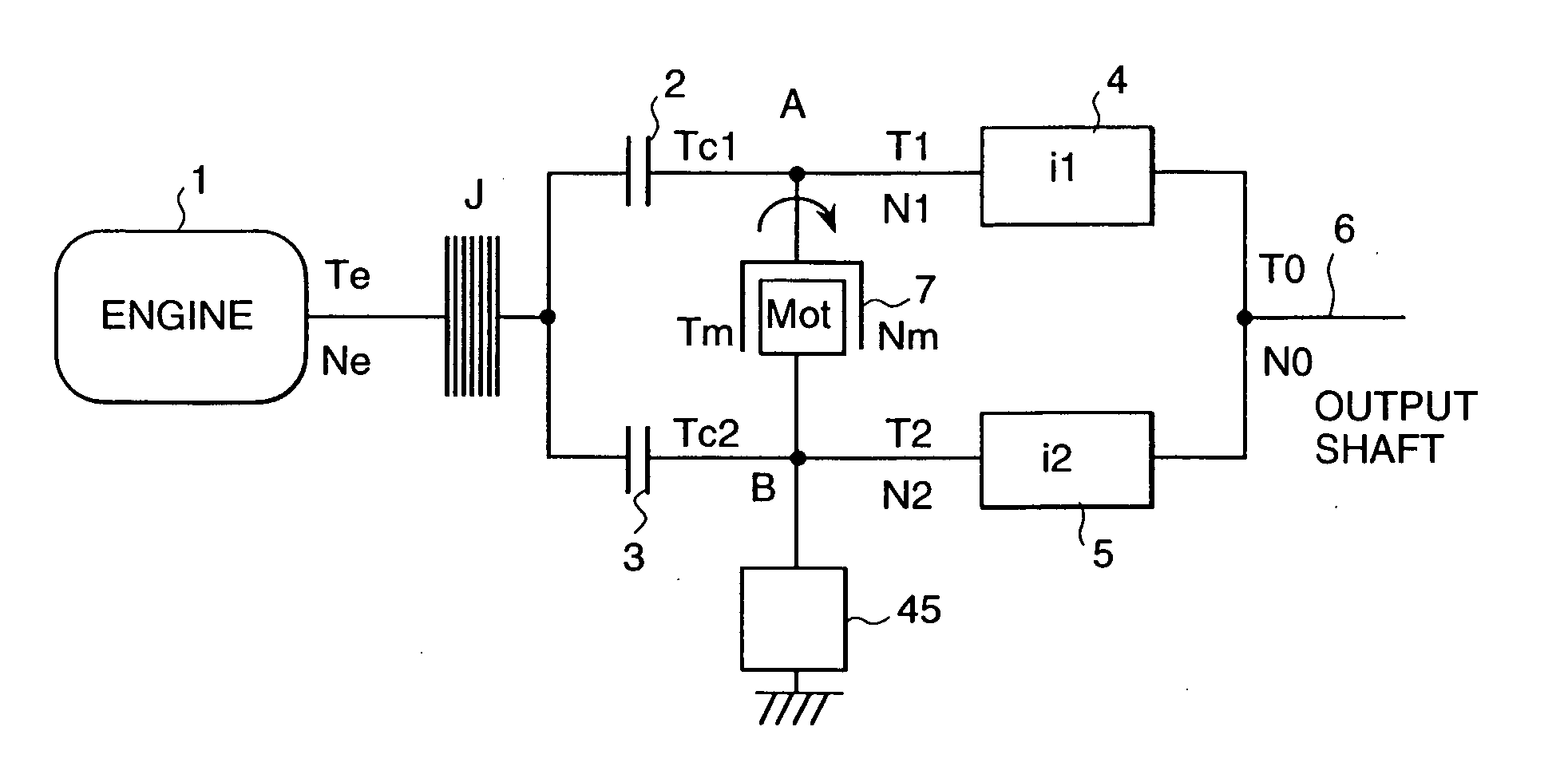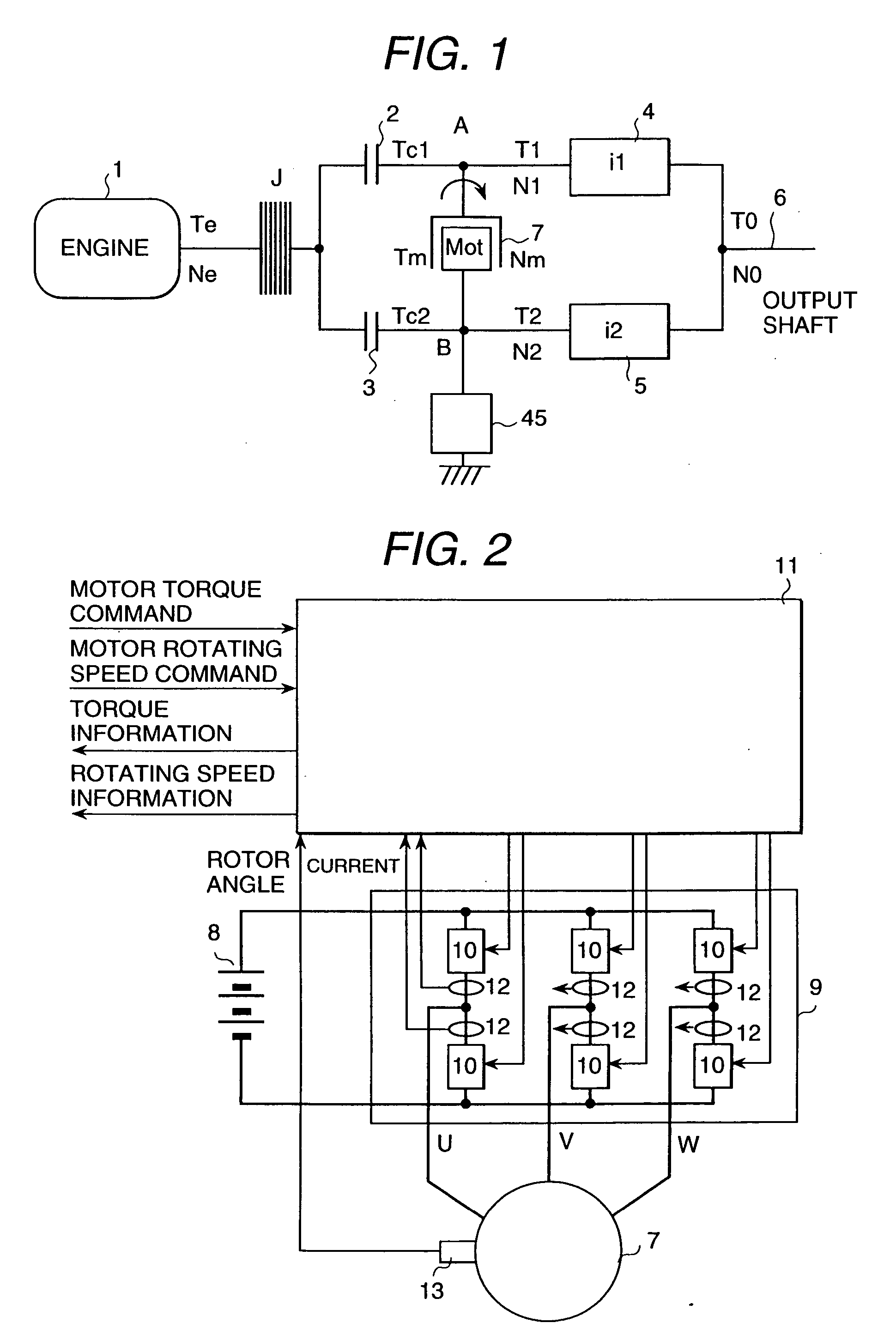Automatic transmission, dynamo-electric machine, and car
a technology of automatic transmission and dynamoelectric machine, which is applied in the direction of engine starters, vehicle sub-unit features, and gearing, etc., can solve the problems of inability to principally perform torque transfer, inability to control stably, and inability to inevitably shorten the life of the engine, so as to achieve continuous torque adjustment, save fuel, and the effect of constant torque adjustmen
- Summary
- Abstract
- Description
- Claims
- Application Information
AI Technical Summary
Benefits of technology
Problems solved by technology
Method used
Image
Examples
second embodiment
The engine load control by the motor torque after engine starting-up and the clutch synchronizing control with reference to the motor speed are equivalent to the operations for shifting up gears as described in the second embodiment, which corresponds to the torque phase and the inertia phase, respectively, considered as the 0-to-1 gear shift operation. Therefore, as this process is related to the potential energy moving from high level to low level, the engine output during this process is used for charging the battery and gradually transfer the energy to the output shaft. There is such as effect that this control can be performed even if the battery remaining is small, and that the reliability can be increased.
By means that the battery remaining information is supplied into the automobile starting control part 46 in the block diagram of FIG. 10, if the battery remaining is larger, the automobile starting control is performed in the method of the forth embodiment in order to incre...
ninth embodiment
the present invention reduce the emission of the injurious ingredient in the exhaust gas immediately after starting the engine, and its control procedure is shown in FIG. 20. The structure of the transmission used in this embodiment is identical to that shown in FIG. 10. The control method of the structure element is identical to the method in the first embodiment. By referring to FIG. 10 and FIG. 20, the control scheme of the exhaust gas reduction control is described.
If the key switch is turned into the starting position while the select lever is staying at P-range, the engine temperature is judged in Step 1, and if the temperature is below the preset value, the reverse gear is engaged in Step 2 and the first clutch is engaged in Step 3. When the motor torque instruction part 14 generates the automobile starting torque instruction in Step 4, as the stator 39 of the electric motor 7 rotates the output shaft 37 of the first clutch, it rotates the engine through the first clutch 2. ...
tenth embodiment
FIG. 21 is a flow chart of R-to-D or D-to-R selection control of the present invention, and FIG. 22 shows a time chart of its individual waveform data. The transmission to be used is assumed to be as shown in FIG. 17. For example, suppose that R-to-D selection is performed while the automobile moves backward and then it continues to run in the forward direction. This way of running the automobile is such a familiar driving pattern that the automobile moves backward outside the garage and turns its direction, and that is called switch turn.
The process from the engine starting to the automobile starting while moving backward are described with the steps up to Step 11 of FIG. 18 in the embodiment 6. Assuming that the select lever is changed to D-range during the reverse running and with the acceleration pedal being pressed, the engine torque and the engine speed are supposed to be kept constant. The range is judged in Step 1 of FIG. 21, and if the range is D-range, the motor speed is ...
PUM
 Login to View More
Login to View More Abstract
Description
Claims
Application Information
 Login to View More
Login to View More - R&D
- Intellectual Property
- Life Sciences
- Materials
- Tech Scout
- Unparalleled Data Quality
- Higher Quality Content
- 60% Fewer Hallucinations
Browse by: Latest US Patents, China's latest patents, Technical Efficacy Thesaurus, Application Domain, Technology Topic, Popular Technical Reports.
© 2025 PatSnap. All rights reserved.Legal|Privacy policy|Modern Slavery Act Transparency Statement|Sitemap|About US| Contact US: help@patsnap.com



